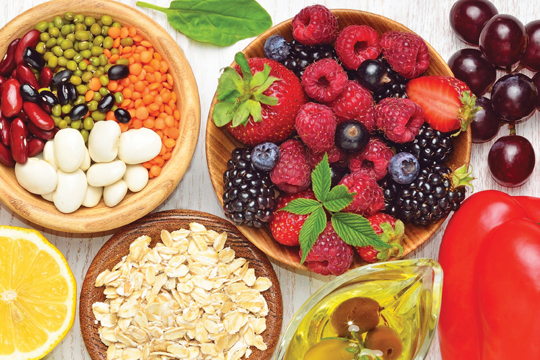
There’s evidence that proper nutrition is a powerful tool in fighting inflammation.
A new study suggests eating brightly coloured fruits and vegetables such as watermelon oranges, spinach and carrots — known collectively as carotenoid-rich foods — can help women fight off visual and cognitive loss as they age.
The antioxidant and anti-inflammatory nature of these foods can combat neurodegenerative diseases such as macular degeneration and some forms of dementia, diseases that disproportionately impact aging women, according to research from the University of Georgia.
But you don’t have to be a woman like Barb Walters to adjust your diet to enjoy a better quality of life as you age. “There are so many things that make up being healthy,” says Walters, an Association member since 2013 who lives in Kingston, Ont. “A lot of it is nutrition. You change the things you can change.”
Retired from the Canada Revenue Agency, Walters has upped her vegetable, fruit and fish intake. As well she’s cut back on packaged meals, which may be convenient, but are typically high in sodium and other potentially harmful ingredients.
She’s also discovered the glories
of kale, a nutrition superstar and a carotenoid-packed vegetable. She avoids cooking kale (put it in a pot with water and “it goes flat — just kind of dies in front of you”) but she happily sprinkles it raw on all kinds of dishes, including one of her favourites: an omelette with cheese and mushrooms.
Diet and aging are a complex affair involving more than just sprinkling vegetables, and you may want to discuss eating with your health-care provider. But here’s some of what you need to know.
Anti-inflammatories and good health
Leslie Beck, a Toronto nutritionist and weekly columnist with The Globe and Mail, is all for smart dietary changes regardless of age. That includes more “plant-forward” anti-inflammatory ingredients such as green leafy vegetables, colourful fruits such as blueberries and strawberries, whole grains, nuts and seeds, beans and lentils as well as oily fish such as salmon, mackerel, tuna and sardines.
“There’s an abundance of evidence,” she says, “that eating an anti-inflammatory diet while limiting foods that are inflammatory — processed and red meats, added sugars, refined carbohydrates, unhealthy fats — is associated with protection from numerous chronic diseases: heart disease, Type 2 diabetes, depression, arthritis [and] a slower rate of cognitive decline and reduced risk of Alzheimer’s dementia.”
Such protection is important because of the inflammation that accompanies aging (a process known as “inflammaging.”) Our bodies naturally produce an inflammatory response to help us heal from an injury or fight off a virus, but that’s normally balanced by a natural anti-inflammatory mechanism. As we age, that anti-inflammatory capacity decreases, leading to chronic inflammation that can damage cells and result in disease.
Eating properly, along with exercise, not smoking and other preventive measures reduce the risk of the inflammatory diseases Beck cites.
The dietary gold standard
The gold standard of anti-inflammatory eating is the Mediterranean diet, Beck says. Rooted in the traditional cuisines of Italy, Greece and other neighbouring countries, it emphasizes plant-based foods, including whole grains, legumes, vegetables and the like, olive oil, some fish, poultry and dairy, and only occasional red meat and sweets.
Beck also mentions the DASH (Dietary Approaches to Stop Hypertension) diet, which emphasizes fruits, vegetables, whole grains and lean meat and was developed to combat high blood pressure and the risk of heart disease.
The MIND (Mediterranean-DASH Diet Intervention for Neurodegenerative Delay) diet blends the two systems with the goal of helping keep the aging brain healthy. It has specific dietary guidelines such as two-plus servings of berries per week and three-plus servings a day of whole grains.
The MIND diet also has convincing results. Beck says research shows a 53 per cent lower rate of Alzheimer’s disease in subjects who followed the diet rigorously and a 35 per cent lower rate among those who stuck to it only moderately. “Even doing some of it offers protection.”
When combined with a balanced food plan, the MIND diet can also promote healthy weight loss.

To eat well on a budget, Barb Walters turns bruised fruit into smoothies and buys some tinned food in bulk. She likes fresh kale sprinkled over her omelettes.
Changing bodies, changing diets
Because our bodies change as we age, other dietary needs may change as well, according to the Canadian Digestive Health Foundation.
For example, Vitamin B12, which cannot be made by our bodies, but is essential for red blood cell creation, nerve health and other needs, can be harder to absorb as we age because of changes to stomach acid or the effect of medications. Fatigue, migraines, poor concentration and balance may result. B12 injections and supplements could be suggested by your doctor, but a variety of meats, eggs, milk and soy products can help prevent the condition.
Protein helps maintain muscle mass and strength, which decline with age, but are critical in reducing physical disability and retaining quality of life. Meat, including beef, poultry, fish, eggs, dairy, beans, quinoa and soy are all good protein sources.
People over 60 should consume 1.1 to 1.2 grams or more of protein per kilogram of body weight daily, Beck says, as well as using resistance training to increase muscle mass. “But it’s not just the amount per day, it’s how you’re spreading it over the day. Research suggests that people who have better muscle strength divide it over three meals versus those who just skew it to the end of the day at dinner. You need to include some protein at each meal.”
Healthy sleep and skin
Our sleep patterns change as we age (see our story on sleep hygiene in the 2021 summer issue of Sage), often making it difficult to get a good night’s rest. But the caffeine in that late-night soft drink or chocolate snack doesn’t help matters, and spicy food within three hours of bedtime can also keep you tossing and turning, according to a Johns Hopkins sleep expert. For a good rest, try whole-wheat toast or a bowl of oatmeal before turning in — they both release the sleep-inducing hormone serotonin.
And don’t forget about your skin, which helps protect your organs and cells, assists in regulating your body temperature and more. There’s evidence that foods like colourful fruits and vegetables (there they are again) can do everything from helping maintain skin barrier health to reducing wrinkles.
The cost of eating well
With food prices soaring, can you still afford to eat well?
Yes, Beck says. She suggests frozen berries (cheaper than fresh, they’re also part of the MIND regimen), winter squash and cabbage (they both go a long way), homemade soups with black beans and lentils instead of pricey red meat (rinse tinned beans and lentils to get rid of excess sodium), and canned salmon and tuna (cheaper than fresh steaks or fillets, they’re loaded with essentials like omega-3, which helps combat heart and other diseases.)
“But I would spend a little more money, again I’m thinking of brain health, on those leafy greens — things like Romaine lettuce, leaf lettuce. Other leafy greens like kale and spinach, you can buy frozen.”
Walters eats well on a budget by turning marked-down, bruised fruit into smoothies, loading up on protein and fibre at lunch with an egg and toasted whole-grain bread, and buying some tinned food in bulk.
“I’ve even experimented with (the herb) savory by buying it fresh when it’s cheap, hanging it upside down to dry and sprinkling it on a chicken or turkey breast. It takes a bit of time, but everything has a price.”
More resources on diet and aging
- Canada’s Food Guide: Healthy eating for seniors
- Harvard Medical School: Foods that fight inflammation
- Washington Post: Healthy eating plans for aging well
- Canadian Digestive Health Foundation: Diet & nutrition tips for seniors and their caregivers
- Lesliebeck.com: Nutrition for older adults

